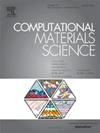多孔电极中扩散-变形-断裂多物理场耦合的相场模型
IF 3.3
3区 材料科学
Q2 MATERIALS SCIENCE, MULTIDISCIPLINARY
引用次数: 0
摘要
随着电动汽车和可再生能源技术的快速发展,锂离子电池(LIBs)作为主要的储能设备发挥着至关重要的作用。然而,随着电池尺寸的增加和性能要求的提高,电池组件的可靠性和耐用性变得至关重要。本文基于商业软件ABAQUS的自定义元(UEL)子程序,建立了多孔电极中扩散-变形-破裂多物理场耦合相场模型,并通过二次开发实现了该模型的数值化。该模型能够有效模拟锂离子扩散诱导应力耦合下多孔电极的裂纹萌生、扩展和裂纹合并行为,实现了孔隙存在导致的化学与力学耦合的复杂裂纹扩展机制。研究结果表明,静水应力和由此产生的浓度变化对多孔电极的裂纹扩展有显著影响。同时,裂缝宽度随裂缝长度尺度参数的增大而增大。在多孔电极中,较低的临界能量释放率可使裂纹萌生时间提前,裂纹扩展速度加快。这些结果有助于更深入地了解lib中多孔电极的结构完整性和性能,并对提高lib设计和优化中的可靠性和性能具有重要意义。本文章由计算机程序翻译,如有差异,请以英文原文为准。

A phase field model for coupling diffusion-deformation-fracture multi-physics in porous electrodes
With the rapid advancements in electric vehicles and renewable energy technologies, Li-ion batteries (LIBs) play a crucial role as primary energy storage devices. However, as battery sizes increase and performance demands rise, the reliability and durability of battery components become paramount. In this investigation, a phase field model coupling diffusion-deformation-fracture multi-physics in porous electrodes is developed and implemented numerically through secondary development based on the Uer-defined element (UEL) subroutine of the commercial software ABAQUS. The model without pre-existing crack is capable of simulating efficiently the behaviors of crack initiation, propagation, and crack merging of porous electrodes coupled Li-ion diffusion-induced stress, enabling the complex crack propagation mechanism of coupling chemical and mechanical phenomena due to the presence of pores. The research findings reveal that both hydrostatic stress and the resultant concentration variations significantly influence crack propagation in porous electrodes. Concurrently, the crack width broadens with increasing crack length scale parameter. Lower critical energy release rates induce earlier crack initiation and accelerate crack propagation velocity in porous electrodes. These results contribute to a deeper understanding of the structural integrity and performance of porous electrodes in LIBs, and have implications for enhancing their reliability and performance in the design and optimization of LIBs.
求助全文
通过发布文献求助,成功后即可免费获取论文全文。
去求助
来源期刊

Computational Materials Science
工程技术-材料科学:综合
CiteScore
6.50
自引率
6.10%
发文量
665
审稿时长
26 days
期刊介绍:
The goal of Computational Materials Science is to report on results that provide new or unique insights into, or significantly expand our understanding of, the properties of materials or phenomena associated with their design, synthesis, processing, characterization, and utilization. To be relevant to the journal, the results should be applied or applicable to specific material systems that are discussed within the submission.
 求助内容:
求助内容: 应助结果提醒方式:
应助结果提醒方式:


